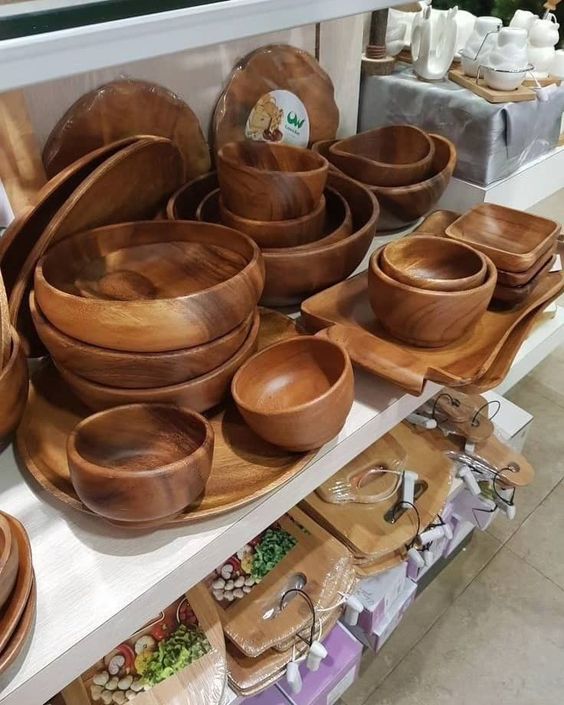The Natural Choice: Why Wood is the Better Material for Drinking, Serving, and Eating
In an era of increasing environmental awareness and health consciousness, choosing the materials we use daily—from water bottles to cutting boards—has become more than a matter of preference. It’s about choosing products that support our well-being and the planet. When it comes to kitchen and dining products, wood has emerged as a favorite alternative to plastic and certain metals, offering benefits that go beyond aesthetics.

So, what makes wood such a great option for drinking, serving, eating, and preparing food? Let’s explore the natural advantages of using wood in the kitchen.
1. A Healthier Choice for You
When it comes to drinking, eating, and preparing food, choosing materials that don’t leach chemicals or pollutants is essential.
Plastic Concerns: Many plastic containers and utensils contain chemicals like BPA and phthalates. Over time, these can leach into food and drinks, especially when exposed to heat or acidic contents, posing health risks.
The Wood Advantage: Wood is naturally free of harmful chemicals and doesn’t release any pollutants into food or drink. In this way, it’s one of the safest materials for water containers, serving platters, bowls, and cutting boards. The natural structure of wood ensures that your food and beverages remain pure and untainted by chemicals.
2. Antibacterial and Antimicrobial Properties
Wood has a natural defense system against bacteria and microorganisms, making it an especially good choice for kitchen use.
Plastic Buildup: Plastics can develop scratches, which trap food particles and moisture, creating an environment where bacteria can thrive. Even thorough washing doesn’t always remove all the harmful bacteria from plastic surfaces.
Wood’s Natural Protection: Some types of wood, such as acacia and oak, have antibacterial properties due to compounds like tannins and polyphenols. These compounds naturally fight bacteria and slow its growth. Additionally, wood has self-healing properties; it can close tiny cuts and scratches, reducing bacterial buildup over time. Research has shown that bacteria like Salmonella and E. coli are less likely to survive on wood surfaces compared to plastic, making it a better choice for cutting boards and serving trays.
3. Environmental Benefits of Choosing Wood
Switching to wood isn’t just a choice for personal health; it’s also a choice for the health of the planet.
Plastic Pollution: Plastic production and waste are major contributors to pollution and environmental degradation. Most plastic items are not biodegradable and can take hundreds of years to break down, filling up landfills and polluting oceans, harming marine life and ecosystems.
Sustainable and Biodegradable: Wood is a renewable resource, especially when sourced from sustainably managed forests. It is also biodegradable, which means that at the end of its life cycle, it will break down naturally, leaving no harmful residues behind. By choosing wood over plastic, you’re helping to reduce your environmental footprint.
4. Aesthetics and Design: Bringing Nature Indoors
There’s a reason wooden décor and kitchenware have been timeless choices—they bring a touch of nature and warmth to any space.

Natural Beauty: Each wooden item is unique, with natural grain patterns and textures that can make each piece look like a small work of art. Whether it’s a drinking cup, a serving board, or a salad bowl, wood adds a rustic, elegant feel to dining spaces.
Functional Elegance: Wooden items are often crafted to be both functional and decorative. Wooden trays, for example, can serve as serving boards or as beautiful centerpieces on a dining table. This versatility makes wooden items not only practical but also visually appealing.
5. Durability and Longevity
When treated with care, wood can last for years, making it a practical and economical choice in the long run.
Short Lifespan of Plastic: Plastic containers and utensils are more prone to damage, warping, and chemical degradation, especially if exposed to high temperatures. Frequent replacement of plastic items means more waste and higher costs over time.
Wood’s Longevity: Wooden items can last a lifetime if properly maintained. Regular oiling and cleaning can keep wooden boards and utensils in top shape, reducing the need for frequent replacement. Wood also withstands daily wear and tear well, making it perfect for cutting boards and kitchen utensils.
6. Thermal Insulation and Comfort
Wood’s natural insulation properties make it a comfortable choice for serving hot and cold foods.
Plastic and Metal Drawbacks: Plastic is a poor insulator and can become brittle when exposed to cold or release toxins when exposed to heat. Metal, on the other hand, can conduct heat quickly, making it difficult to handle for hot food and drinks.
Wood’s Comfort: Wood retains temperature well without absorbing extreme heat or cold, allowing it to maintain a balanced temperature. This makes wooden cups and containers great for drinking water or holding food without the need for insulation.

How to Care for Wooden Kitchenware
Wooden items need a bit of care to maintain their quality and appearance. Here are some simple tips:
- Regular Oiling: Apply a food-safe mineral oil or beeswax every month to keep wood from drying out.
- Gentle Washing: Avoid soaking wooden items in water; instead, wash them with mild soap and water, then dry them immediately.
- Avoid Dishwashers: Dishwashers can damage wood by exposing it to high heat and moisture.
In Summary
Switching to wood over plastic and certain metals offers a range of benefits, from health and environmental advantages to aesthetics and functionality. While drinking water from a wooden container may not add unique nutrients to the water, it does avoid leaching harmful chemicals and brings a touch of natural beauty to everyday life.
Making small changes, like choosing wooden bowls, cups, and cutting boards, supports a sustainable lifestyle, reduces plastic pollution, and elevates your home environment with items crafted by nature. Choose wood and take a step toward a healthier, more sustainable lifestyle that’s good for both you and the planet.
By embracing wood in our daily routines, we’re choosing materials that are safe, sustainable, and timelessly stylish.


